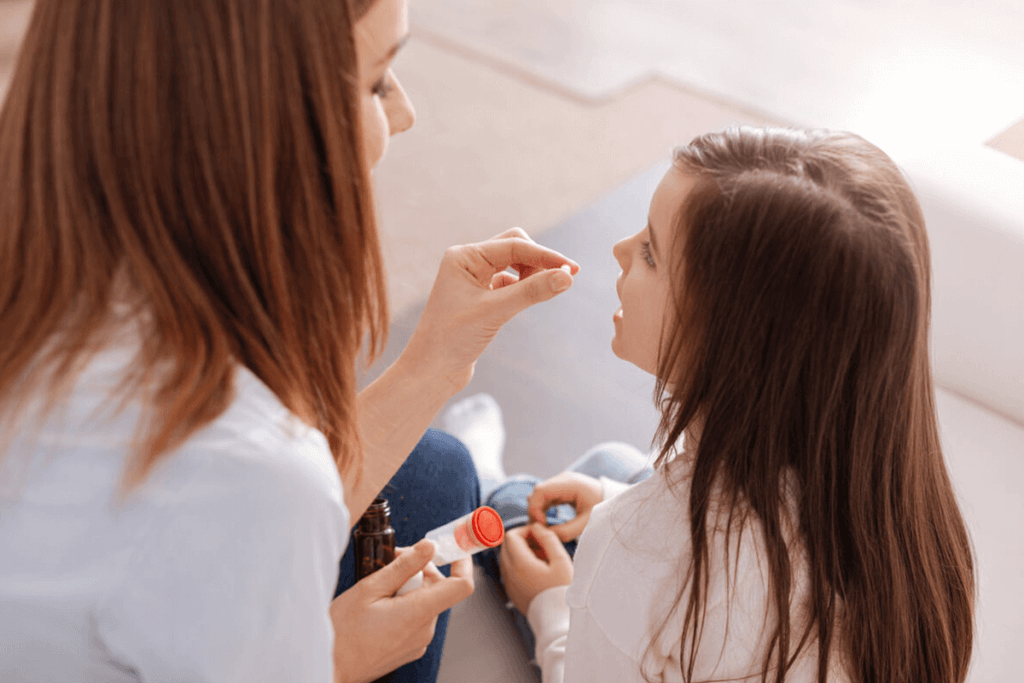
Skin manifestations in digestive conditions
Supporting the presence of the gut-skin axis, it has been observed that several digestive pathologies are often accompanied with skin co-morbidities. (10)(12)(13) Approximately 24% of individuals with Crohn’s disease and 14% of individuals with ulcerative colitis also present with skin conditions. In Crohn’s disease, individuals are more likely to develop both psoriasis and erythema nodosum, a common form of panniculitis often characterized by painful rounded nodules on the lower extremities. (2) Those with ulcerative colitis, on the other hand, commonly experience cutaneous ulcers known as pyoderma gangrenosum. Similarly, individuals with inflammatory bowel disease (IBD) are more likely to experience oral lesions, and other skin conditions, including Sweet’s Syndrome, pyoderma gangrenosum, and erythema nodosum. (15) Furthermore, it has been shown that individuals with celiac disease often suffer from oral lesions, hair loss, and vitiligo, a condition characterized by the destruction of skin pigment cells. Dermatitis herpetiformis is a form of dermatitis that occurs in approximately ¼ of individuals with Celiac disease. (12)(15) Another inflammatory skin condition, rosacea, has been associated with Helicobacter pylori infection and a higher incidence of small intestinal bacterial overgrowth (SIBO). (6)(11)
The gut microbiota and skin conditions
While the underlying mechanisms explaining the gut-skin axis remain to be established, (15) it has been suggested that this interconnection may involve the gut microbiota and their by-products (metabolites), as well as their modulatory effect on systemic immunity. (10)(13)(15) Metabolites of intestinal bacteria, including neurotransmitters, hormones, and other compounds, such as short-chain fatty acids (SCFAs), may enter the bloodstream and induce effects on the skin or the skin microbiota. (15) It has also been suggested that the composition of microbes in the digestive tract may contribute to the development of certain skin conditions. (9) Studies have observed imbalances of the gut and skin microbiomes, known as dysbiosis, in a number of common skin conditions, including acne, rosacea, psoriasis, and atopic dermatitis (AD). (13)(15) These findings have led to the consideration of probiotic supplementation as a method of modulating the intestinal microbiota and preventing or treating a number of these skin conditions. (13)Atopic dermatitis (eczema)
Atopic dermatitis (AD) is a common chronic inflammatory skin condition, (9) affecting approximately 15-30% of children and 2–10% of adults. The development of AD is related to alterations in skin barrier function and immune responses. (13) Research has also demonstrated an association between dysbiosis and AD. Greater diversity in intestinal microbes has been linked to reduced recurrence of inflammatory skin conditions. (15) Several studies have demonstrated the effectiveness of probiotic supplementation in the prevention and treatment of AD. (13) A randomized, double-blind, placebo-controlled trial examined the effects of prenatal and postnatal probiotic supplementation on the incidence of AD. One hundred and twelve pregnant women were given a probiotic mixture (B. bifidum, B. lactis, and L. acidophilus) or a placebo once per day, from four to eight weeks before delivery to six months after delivery. After one year, probiotic intake was associated with a significantly lower incidence of AD compared to the placebo group, suggesting that probiotic supplementation may be effective in preventing AD in infants. (8) In another nonrandomized study, 14 pediatric patients with resistant AD received 300 mg to 500 mg daily of standardized L. rhamnosus cell lysate. Results demonstrated improvements in skin symptoms, irritation, and quality of life. (5) A 2016 meta-analysis of randomized controlled trials also found synbiotics, composed of prebiotics and mixed probiotic strains, to be particularly effective in the treatment of AD in children greater than one-year-old. (1)
Acne vulgaris
Acne vulgaris, a chronic skin condition of the pilosebaceous unit, affects approximately 85% of individuals between the ages of 12 and 25. The condition is particularly common in western countries possibly due to the high consumption of processed carbohydrates in these areas. (13) Studies dating back to the 1960s have shown promise for probiotic supplementation in the treatment and prevention of acne. In one study, 300 individuals were given oral probiotic supplements composed of L. acidophilus and L. bulgaricus. Improvements in acne were observed in 80% of subjects. (13) More recently, researchers have noted the involvement of both the gut-skin axis and insulin signalling dysfunction in the pathogenesis of acne. In a randomised, double-blinded, placebo-controlled study, 20 adults were given a liquid L. rhamnosus probiotic supplement or a placebo. Probiotic supplementation improved skin expression of insulin signalling genes and appearance of acne. (3) Probiotic supplementation may also be effective as an adjunct to conventional antibiotic treatment. In a 2013 study, 45 female subjects were randomly assigned to receive a probiotic supplement, antibiotic treatment (minocycline), or both. Results demonstrated improvements in skin lesions is all groups, with the greatest improvement observed in the group receiving the combination of probiotic and antibiotic treatment. These findings indicate that the use of probiotics on their own or as an adjunct to antibiotics may be considered in the treatment of acne. (7)Psoriasis
Psoriasis is a chronic inflammatory skin condition characterized by the appearance of erythematous scaly plaques. It is an immune-mediated condition that may be triggered by a number of internal and environmental factors in genetically susceptible individuals. (13) Research has noted a lower diversity of intestinal microbes in individuals with psoriasis (14) and it has been suggested that probiotic supplementation may be an effective treatment option. While the majority of research has been limited to case studies and animal trials, (13) one human study found that probiotic supplementation may improve biomarkers of inflammation associated with psoriasis. In a series of randomized, double-blind, placebo-controlled trials, the effects of oral B. infantis supplementation on inflammatory markers and plasma cytokine levels were examined in patients with inflammatory disorders, including psoriasis. The results demonstrated the effectiveness of B. infantis supplementation in reducing pro-inflammatory biomarkers in gastrointestinal and non-gastrointestinal conditions. Specifically, B. infantis reduced reduced plasma CRP and plasma TNF-α in subjects with psoriasis. (4)The bottom line
Current research suggests a significant connection between the gut and skin demonstrated by the concurrence of certain digestive and skin conditions, as well as the presence of dysbiosis and effectiveness of probiotic supplementation in AD, acne, and psoriasis. While results thus far have been promising, research is needed to further establish the underlying mechanisms of the gut-skin axis. If you’re a patient, speak to your integrative healthcare practitioner for further information and guidance when using probiotics to effectively treat skin conditions.- Chang, Y.S., Trivedi, M.K., Jha, A., Lin, Y.F., Dimaano, L., & García-Romero, M.T. (2016). Synbiotics for prevention and treatment of atopic dermatitis: A meta-analysis of randomized clinical trials. JAMA Pediatrics, 170(3), 236-42.
- Chowaniec, M., Starba, A., & Wiland, P. (2016). Erythema nodosum – Review of the literature. Reumatologia, 54(2), 79–82.
- Fabbrocini, G., Bertona, M., Picazo, Ó., Pareja-Galeano, H., Monfrecola, G., & Emanuele, E. (2016). Supplementation with Lactobacillus rhamnosus SP1 normalises skin expression of genes implicated in insulin signalling and improves adult acne. Beneficial Microbes, 7(5), 625-630.
- Groeger, D., O’Mahony, L., Murphy, E. F., Bourke, J. F., Dinan, T. G., Kiely, B., … Quigley, E. M. (2013). Bifidobacterium infantis 35624 modulates host inflammatory processes beyond the gut. Gut Microbes, 4(4), 325–339.
- Hoang, B.X., Shaw, G., Pham, P., & Levine, S.A. (2010). Lactobacillus rhamnosus cell lysate in the management of resistant childhood atopic eczema. Inflammation & Allergy – Drug Targets, 9(3), 192-6.
- Holmes, A.D. (2013). Potential role of microorganisms in the pathogenesis of rosacea. Journal of the American Academy of Dermatology, 69(6), 1025-32.
- Jung, G.W., Tse, J.E., Guiha, I., & Rao, J. (2013). Prospective, randomized, open-label trial comparing the safety, efficacy, and tolerability of an acne treatment regimen with and without a probiotic supplement and minocycline in subjects with mild to moderate acne. Journal of Cutaneous Medicine and Surgery, 17(2), 114-22.
- Kim, J.Y., Kwon, J.H., Ahn, S.H., Lee, S.I., Han, Y.S., Choi, Y.O., … Ji, G.E. (2010). Effect of probiotic mix (Bifidobacterium bifidum, Bifidobacterium lactis, Lactobacillus acidophilus) in the primary prevention of eczema: A double-blind, randomized, placebo-controlled trial. Pediatric Allergy and Immunology, 21(2 Pt 2), e386-93.
- Lee, S. Y., Lee, E., Park, Y. M., & Hong, S. J. (2018). Microbiome in the gut-skin axis in atopic dermatitis. Allergy, Asthma & Immunology Research, 10(4), 354–362.
- O’Neill, C.A., Monteleone, G., McLaughlin, J.T., & Paus, R. (2016). The gut‐skin axis in health and disease: A paradigm with therapeutic implications. BioEssays, 38(11), 1167-1176.
- Parodi, A., Paolino, S., Greco, A., Drago, F., Mansi, C., Rebora, A., … Savarino, V. (2008). Small intestinal bacterial overgrowth in rosacea: clinical effectiveness of its eradication. Clinical Gastroenterology and Hepatology, 6(7), 759-64.
- Saarialho-Kere, U. (2004). The gut-skin axis. Journal of Pediatric Gastroenterology and Nutrition, 39(Suppl 3), S734-5.
- Salem, I., Ramser, A., Isham, N., & Ghannoum, M. A. (2018). The gut microbiome as a major regulator of the gut-skin axis. Frontiers in Microbiology, 9, 1459.
- Scher, J. U., Ubeda, C., Artacho, A., Attur, M., Isaac, S., Reddy, S. M., … Abramson, S. B. (2015). Decreased bacterial diversity characterizes the altered gut microbiota in patients with psoriatic arthritis, resembling dysbiosis in inflammatory bowel disease. Arthritis & Rheumatology, 67(1), 128–139.
- Vaughn, A.R., Notay, M., Clark, A.K., & Sivamani, R.K. (2017). Skin-gut axis: The relationship between intestinal bacteria and skin health. World Journal of Dermatology, 6(4), 52-58.





